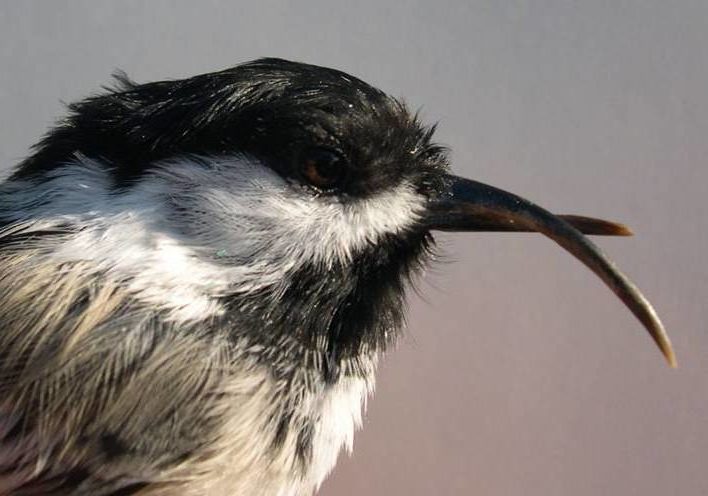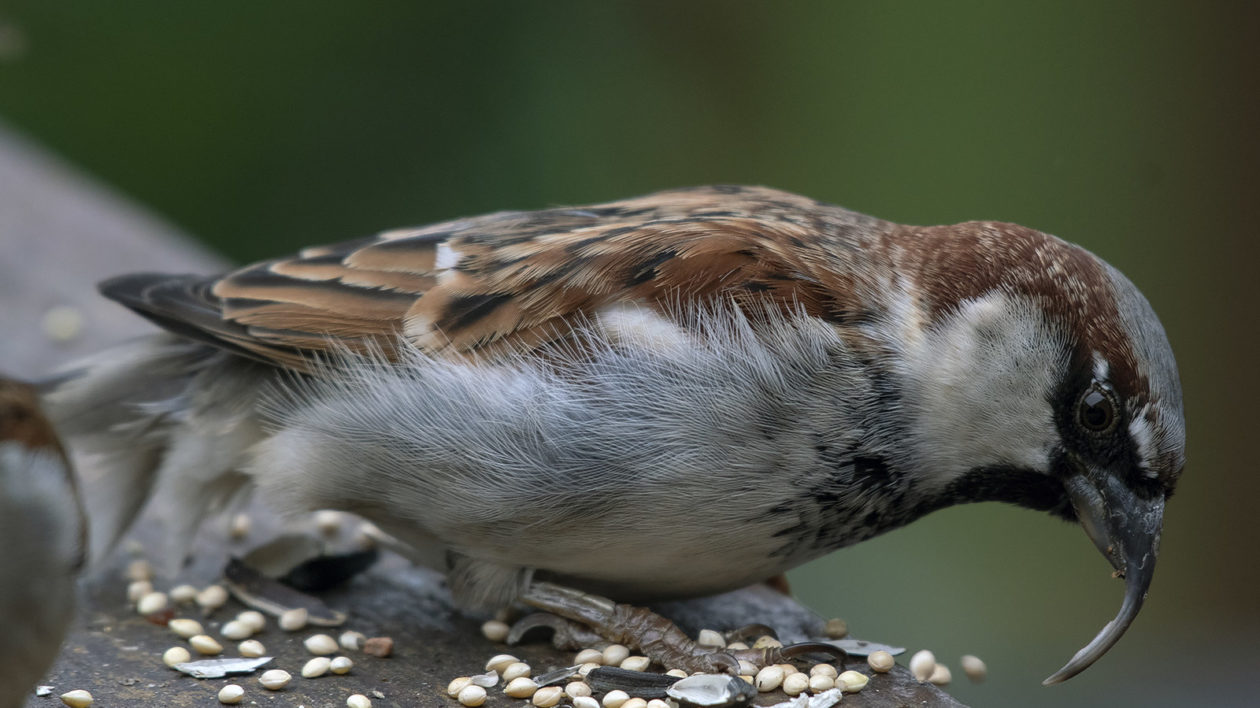Picture a bird as it tries to feed its young—with a beak that is twice as long as normal. This horrifying sight has become an increasingly common sighting since scientists discovered this beak deformity occurring in landbirds throughout North America.
Over the past 20 years, scientists have been observing an increased occurrence of beak deformities in landbirds, specifically black-capped chickadees (Poecile atricapillus) and other resident birds in Alaska. Dr. Colleen Handel, Research Wildlife Biologist and founder of the Landbird Ecology Program at the United States Geological Survey (USGS) Alaska Science Center, was the first to discover and connect prior curiosity and observations to these emerging deformities.
“My friend and colleague Sandra Talbot who heads our genetics laboratory at the Alaska Science Center, told me about three black-capped chickadees with abnormally long and curved beaks that she’d observed coming to her feeders at her home in south Anchorage, Alaska,” says Handel.

Handel took to the books and reviewed any published literature noting beak deformities in birds and found that similar abnormalities had been reported occasionally around the world in multiple species. Although there were sporadic reports, there was never a single common cause noted.
Given the limited home range of resident chickadees and this relatively small cluster deformities in Alaska, she dismissed these anomalous individuals as a coincidence.
Weeks later, after seeing a photograph in the local newspaper of another black-capped chickadee with a similarly overgrown beak that had been taken about 50 miles away from Talbot’s home and initial sighting, Handel realized that the odds had changed, and that her curiosity was, indeed, not a coincidence.
“I quickly put out requests to local Alaska chapters of the National Audubon Society to see if others had been seeing birds with abnormal beaks, and the reports came streaming in,” she says.

Avian Keratin Disease: A New Occurrence
The appearance of these deformities, now termed Avian Keratin Disorder (AKD), was a new occurrence in the state of Alaska. The disease is characterized primarily by beak overgrowth and can also be accompanied by other keratin abnormalities, including in claws and skin. Severely affected birds often have disheveled feathers and struggle to feed normally. The sudden appearance of AKD in Alaska signaled a rapidly emerging disease among wild birds and scientists were eager to get to work to gain further understanding.
“I felt it imperative to begin asking questions about how many other affected individuals [were] out there, what species [were] being affected, where they [were], and what [was] causing these abnormalities,” states Handel. “This is an important wildlife issue and the implications could be far-reaching. Wildlife can be true sentinels of environmental and human health.”
Since AKD is an emerging disease, there is no existing background information, which made room for new discoveries. Scientists found themselves branching into various fields of study, including toxicology, pathology, and ecology to obtain answers to their initial questions about this new finding.
Handel and her team of scientists began to investigate possible causes, some of which included environmental contaminants, genetics, diet, and infectious disease. Dr. Caroline Van Hemert, Research Wildlife Biologist for the USGS Alaska Science Center, was among the team.
“I first helped capture chickadees as part of an ongoing research project on AKD in 2006 and was immediately intrigued,” says Hemert. “It was a scientific mystery, which captured my curiosity, and also had potentially important conservation implications for wild birds.” After further investigation, the team concluded that none of the possible causes of AKD that they had predicted presented convincing evidence.
In 2013, Van Hemert and the team developed a collaboration with the California Academy of Sciences and later, the University of California San Francisco (UCSF). Maxine Zylberberg, a postdoctoral researcher at UCSF, began conducting next-generation sequencing, a type of DNA sequencing, to screen for the presence of a viral pathogen.
Zylberberg’s initial screenings led to the discovery of poecivirus, a type of picornavirus whose occurrence has become a strong suspect candidate as the cause of AKD.

A Future Direction
Poecivirus has been found to be highly correlated with the occurrence of AKD in black-capped chickadees. There also have been several other species with “AKD-like” deformities that have also tested positive for poecivirus, which suggests that it may be implicated in the disease across species.
Although researchers are finishing up analyses of this work, the initial results strongly agree with their preliminary observations.
Although black-capped chickadees continue to present the largest number of documented cases (more than 3,000), scientists have observed other resident birds of Alaska showing signs of AKD. These include a number of corvid species including American crows (Corvus brachyrhynchos), Steller’s jays (Cyanocitta stelleri), black-billed magpies (Pica hudsonia), and common ravens (Corvus corax). Downy woodpeckers (Picoides pubescens), and species of nuthatches have also been observed with AKD. There have also been observations of American crows with AKD occurring throughout the Pacific Northwest.

For this study, researchers rely heavily on citizen science, or the public’s participation in scientific research, in order to document observations of birds with beak deformities, including when and where they are occurring.
Observers are able to submit their sightings using an online reporting form.
Recently, observations of similar deformities seem to be occurring in other species around the world, including the federally endangered red-cockaded woodpecker (Leuconotopicus borealis) in North Carolina, great tits (Parus major) in the United Kingdom, austral thrushes (Turdus falcklandii) in Patagonia, and red-tailed hawks (Buteo jamaicensis) in the Pacific Northwest. Scientists are still working to determine whether these cases are directly linked to AKD.
“The additional clusters of beak deformities in geographically disparate locations is especially intriguing,” says Van Hemert. “Although we don’t know yet whether these represent the same disease as in Alaska, the very similar presentation and other factors make a shared origin plausible.”




Here in Flagstaff, we have repeatedly seen a red shafted flicker with very long, crossed upper and lower beaks. It turns it’s head sideways to feed on suet. Obviously, it would be impossible for it to drill a nesting hole in a tree. Freaky and sad.
Just this year in Tucson, AZ, I have noticed house finches coming to my feeders with an overlong hooked upper beak. They seem to be of normal size but I think that they are having some trouble eating. Is this condition spreadable? I still have finches with normal beaks. Is there anything that I should do – or stop doing? Any advice would be appreciated.
Here in Seattle I have a Stellar’s Jay friend that I’ve been feeding. His(?) lower beak has grown severely to one side and he can’t close his mouth. He comes every morning to get his scrambled eggs and millet on my balcony . He turns his head upside down with crown on ground to eat. It’s been like this for at least 9 months, & he’s perky & cheeky as ever. I’ve named him Handsome.
I hope they can find the cause of these deformities. This breaks my heart….I love birds and I can’t stand to see them suffer.
Hello, I am in Kansas and have seen a few birds with beak deformities. One was a blue jay with curved and overgrown beak, another was a brown bird, maybe a young cardinal, that had a super short upper beak and a longer bottom beak. I have pictures of the blue jay from my ring cam.
Several years ago we had a male Hairy Woodpecker that had an extra long but straight lower mandible. He was only here for a few days. We are in central lower Michigan.
I discovered a female house finch with an extra long bottom beak in North Texas. She was eating just fine. I have saved a video of her eating as well as a couple of pictures. Hopefully the beak won’t grow longer and hopefully she wont suffer.
I found this because I was trying to find out what would cause a similarly long beak on a house wren I’ve seen the last two days in northern Kansas. This one only has abnormal growth on the upper bill and appears to be in good health despite the beak being about twice the normal length. It appears to have mated with a bird with a normal beak, and it will be interesting to see if the trait is passed on.
The summer of 2020 I had a red bellied male woodpecker with a long crossed bill. He stayed the whole summer and fall. He did not return in 2021.
I’ll also wondering if my feeder is helping spread this virus. It seems like if we can catch a bird and clip it’s bill, it might have a chance at a more normal life. It is heartbreaking to see such bill deformity in a chickadee.
Michigan’s Upper Peninsula has had a few cases of deformed beaks in the past few years: 1 Rough-legged Hawk, 1 Cape May Warbler, 1 Red-eyed Vireo. All noticed after photographing them. The process of genetic sequencing of a virus is not science. Here is an example of how they do it: a program can arrange [an outcome] as desired, by putting together short sequences of nucleic acids from dead tissue and cells with a determined biochemical composition, a larger genetic sequence that is supposed to represent the complete genome of an old or new virus. In reality, not even this manipulation, called ‘alignment’, can result in the ‘complete’ genetic material of a virus which could then be called its genome.
How do these birds survive? How do their offspring survive? Is it possible to correct the beaks to make them normal size so they may feed easily?
I never noticed that before. I live close to Palm Springs, CA where it is quite hot during the Summer and no rain. I will keep it in mind and keep an eye out.
So, is the virus the cause of the disease, or an adventitious hitch-hiker resulting from a dietary deficiency or non-lethal toxicity of something else? Do the birds with AKD mostly appear where humans put out food for them, in which case perhaps the virus is carried or spread by foods of human origin? I’m wondering about pesticide residue in the seed or suet foods either supporting the virus or perhaps eliminating the naturally occurring control for the virus…or something. Hopefully this research is ongoing? Citizen science is necessary and important but only goes so far, and can’t replace field and lab research by experts.